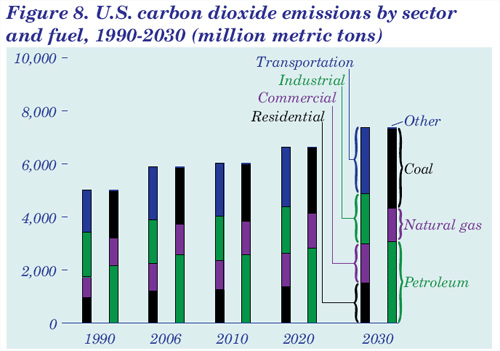US to remain addicted to oil
Overall, US demand for petroleum, the main fuel source for transportation is forecast to rise 0.8 percent a year, from 21 million barrels per day in 2008 to almost 25 million bpd in 2030.
US energy-related carbon dioxide emissions are projected to grow from 5.8 billion tonnes in 2006 to 7.3 billion tonnes in 2030.
The EIA also expects substantial increases in conventional oil production in several OPEC and non-OPEC countries over the next 10 years. It forecasts a drop in oil prices from current levels of US$90 a barrel to US$58 in 2016 (US$70 in nominal dollars) and US$72 in 2030 (US$113 in nominal dollars), as investments in exploration brings new supplies to the world market.
US oil production is anticipated to rise from 5.1 million barrels per day in 2006 to a peak 6.4 million bpd in 2019 due to higher output from deep water drilling in the Gulf of Mexico.

The EIA said its forecast does not reflect legislation being considered by Congress to raise fuel efficiency standards for American cars and trucks by 40 percent by 2020. The forecast also shows that renewable energy in the United States will double by 2030, with the most growth being in ethanol.
U.S. ethanol consumption is forecast to grow from 5.6 billion gallons in 2006 to 13.5 billion gallons in 2012, far more than the 7.5 billion gallons in 2012 required by Congress, the EIA said. Ethanol use is expected to reach 17 billion gallons in 2030. Other renewable energies, particularly wind, are expected to increase significantly in use by 2030.
"The higher level of renewable energy consumption is partially a result of higher energy prices…but it also reflects a revised presentation of state renewable portfolio standards," the Energy Information Administration said.
Unfortunately with a projected increase in energy demand of 21% from 2006 to 2030, renewable energy is overshadowed by the continued dependence on and growth in use of fossil fuels. Most of the ethanol produced in 2030 will also be used in a gasoline blend for automobiles.
At the 2007 Bali Conference for Climate Change, the United States remained the only developed nation to not ratify the Kyoto Protocol and refused to accept any provisional emission reduction targets proposed by conference delegates.
Last week the U.S. Senate passed a highly anticipated energy bill that made the first significant improvement in automobile mileage standards in more than 30 years; however it fell short of original expectations. Two key items were removed from the bill; the elimination of tax breaks given to oil companies which would free up $12 billion of funding to alternate fuel technology development and renewable energy requirements for the utility industry.
Despite the disappointment at Bali and with the energy bill, US legislators will have another chance to show leadership on climate change. An ambitious bill aimed at cutting America’s greenhouse gas emissions by 70 percent by midcentury has been approved by a Senate committee and may come to the floor next year.
For More Information: PlanetArk
You can return to the main Market News page, or press the Back button on your browser.

